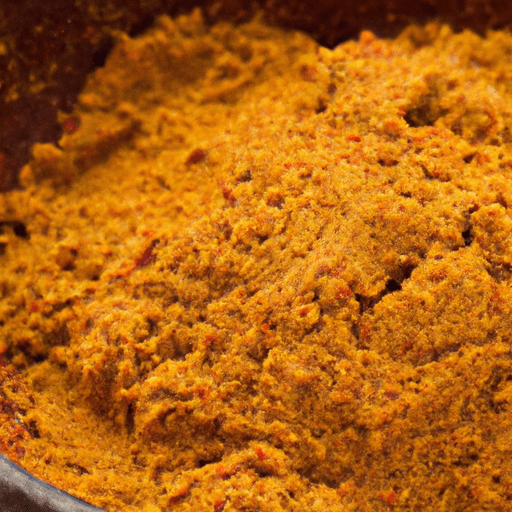Red Curry Paste: A Burst of Flavor for Your Favorite Dishes
If you’re a fan of Thai cuisine or love experimenting with bold and vibrant flavors, then red curry paste is a must-have ingredient in your pantry. This versatile and aromatic paste is filled with a perfect balance of spices, delivering a fascinating explosion of flavors to any dish it touches. In this article, we will explore the intricate details of red curry paste, including its taste profile, common uses in cooking, nutritional value, and some fascinating facts about its history.
Taste Profile
Red curry paste is known for its tantalizing combination of flavors that will leave your taste buds craving for more. It boasts a pleasant heat from red chili peppers, which is beautifully complemented by the earthiness of garlic and shallots. The paste also features aromatic herbs such as lemongrass and galangal, adding a zesty and refreshing note to its overall taste profile. The depth of flavor is further enhanced by the addition of spices like cumin, coriander, and cardamom, resulting in a rich and complex flavor that is both savory and slightly sweet.
Common Uses in Cooking
Red curry paste is an incredibly versatile ingredient that can be used in a wide range of recipes. Its robust flavors make it a perfect accompaniment for various proteins like chicken, beef, shrimp, or tofu. Traditional Thai dishes like Red Curry Chicken, Massaman Curry, or Spicy Shrimp Curry often call for a generous amount of red curry paste. However, this spice blend also works wonders as a marinade for grilling or roasting, and it adds a unique kick to soups, stir-fries, or even salad dressings.
Nutritional Value
Aside from its amazing taste, red curry paste also brings some nutritional benefits to the table. It is primarily made up of herbs and spices that are rich in antioxidants, which help protect your body’s cells from damage caused by free radicals. The chili peppers found in red curry paste contain capsaicin, a compound known for its potential anti-inflammatory and metabolism-boosting properties. Additionally, herbs like lemongrass and galangal in the paste can aid digestion and promote overall gut health.
Interesting History and Facts
Red curry paste has a rich history that dates back to the vibrant culinary culture of Thailand. It is believed to have originated in Central Thailand, where the bold flavors of chilies and spices were skillfully combined with local ingredients to create an explosion of taste. Over time, red curry paste has become a staple ingredient not only in Thai cuisine but also in fusion dishes around the world.
Making red curry paste from scratch can be a time-consuming process, as it involves grinding various spices and herbs into a fine paste. However, it’s readily available in most grocery stores and Asian markets, making it convenient to incorporate into your cooking repertoire.
It’s worth noting that the heat level of red curry paste can vary depending on the brand or homemade recipe. If you prefer a milder flavor, you can always adjust the amount of paste used in your dishes or balance it with ingredients like coconut milk or lime juice.
To make the most of your red curry paste, be sure to store it in an airtight container in the refrigerator. This will help retain its freshness and flavors for an extended period.
In conclusion, red curry paste is a flavor powerhouse that adds depth, heat, and complexity to a wide variety of dishes. Its remarkable taste profile, versatility in cooking, and potential health benefits make it a pantry staple worth exploring. So, why not grab a jar of red curry paste today and embark on a culinary adventure that will tantalize your taste buds like never before?
Red Curry Paste
Origin: Red curry paste is a widely used ingredient in Thai cuisine. It originated in Thailand, where the combination of red chilies, herbs, and spices has been a part of the culinary tradition for centuries.
Ingredients: The key ingredients of red curry paste typically include red chili peppers, garlic, shallots, lemongrass, galangal or ginger, coriander roots or seeds, shrimp paste, and various spices such as cumin, coriander, and pepper. The paste is made by grinding and combining these ingredients.
Common Uses: Red curry paste is commonly used as a base for making Thai red curries, which can include meat, poultry, seafood, or vegetables. It adds a vibrant red color, complex flavors, and a spicy kick to the dishes. It can also be used to flavor soups, stir-fries, marinades, and dipping sauces.
Nutritional Benefits: Red curry paste contains several ingredients that offer nutritional benefits. Garlic and ginger are known for their potential immune-boosting properties, while chili peppers contain capsaicin, which may help with metabolism and reduce inflammation. Additionally, herbs like lemongrass and coriander have antioxidant properties.
Unique Properties: Red curry paste is known for its spicy, aromatic, and complex flavor profile. It brings together the heat of chilies, the tanginess of lemongrass, and the depth of spices to create a distinctive taste. The paste has a long shelf life when stored properly in airtight containers in the refrigerator.
Historical Significance: Traditional Thai curry pastes have been used for centuries, and their history is closely tied to the cross-cultural influences in the region. The introduction of chili peppers by Portuguese traders in the 16th century greatly impacted Thai cuisine, leading to the creation of curry pastes like red curry paste.
Note: Red curry paste can vary slightly in ingredients and proportions depending on regional variations and personal preferences.




Use the share button below if you liked it.
It makes me smile, when I see it.